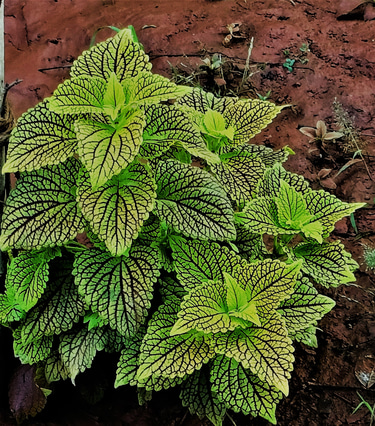Dragon fruits and its cultivation
Dragon fruit plant is a cactus type and it is a tolerant to .extreme arid climate. Fruit produced is very delicious and nutritious as well. Crop can be grown through out tropical and subtropical region.
CROP CULTIVATION
Satish Naik
9/2/20237 min read

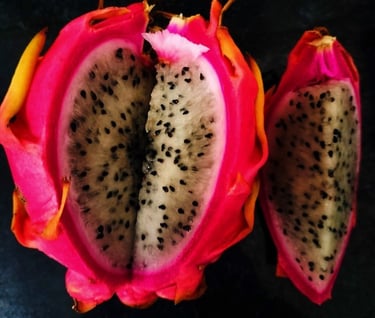
Dragon fruits and their cultivation
Dragon fruits are so called may be because of its scaly spikes in the form of fins, arranged on their surface which resembles fins on dragons, a mythological creature, . Color of the fruits vary from yellow or red or pink where as inner pulp may be of red or white or purple, depending on the species. The fruit is very commonly called as Pitaya or Pitahaya in most of the countries. It rarely called as strawberry pear, may be of its color resemblance to strawberry and shape like pear fruit.
Production status of Dragon fruits in the world
Major producer and exporter of dragon fruit is Vietnam. It contributes about the half of the total world's production and ranks first in area under cultivation and productivity ( 25-35 metric tonnes /ha). That is the reason why fruit is specially called 'Vietnamese Dragon fruit". China and Indonesia are other major producer, together with Vietnam they cover 90 percent of total world's production. Taiwan, Malaysia, Philippines, Costa Rica, El Salvador are other countries producing dragon fruits.
In India, cultivation of Dragon fruits introduced during 1990, but gaining popularity in recent years. Demand for fruits is being increased, leading enhanced scope for commercial cultivation. Since 2018, up ward trend has been noticed in area under cultivation and total production. Large chunk of area under cultivation is of less than three year old plantations and expected to increase in productivity and production in the years to come. Cultivation is prominent in states like Gujarat, Maharashtra, Karnataka, Tamilnadu, Andra Pradesh and Kerala. Gujarat is the state with more area under cultivation, followed by Maharashtra and Karnataka.
Dragon fruits types:
Based the color of the skin and color of inner pulp, there are four types of dragon fruits. :
1. Hylocereus undatus: Red skin with white pulp.
2. Hylocereus polyrhizus: Red skin with red pulp
3. Hylocereus costaricencis: Red skin with purple pulp
4. Hylocereus megalanthus: Yellow skin with white pulp.
Nutrition of Dragon fruits
Use of dragon fruits as part of human diet is getting popularity in recent years on realizing their nutritional benefits. Fruits are used as raw or as juices or salads or as Jams and jellies. Dragon fruits are rich in minerals, vitamins, dietary fibers and antioxidants. As per the data of USDA, 100gms Dragon fruits yield 57 Kcal of energy and contains 83.96 g of water, 15.23g of Carbohydrates, 9.1 g of dietary fiber, negligible amount of fat and proteins, 116 mg of Potassium, 12mg of phosphorous, 9 mg of Calcium, 7 mg of magnesium, 4.30 mg of Vitamin C, 0.161 mg of Niacin, 0.029mg of Vitamin-B6. Fruits are also known for presence of antioxidants like flavonoids and Phenolic acids.
Botany of Dragon fruit plant:
Dragon fruit plants belong to family Cactacea and are climbing type of cactus. They climb the support with the help of aerial roots. Stems are succulent and angular with wavy margin and grow up to height of 20 ft. Stomata meant for transpiration open only during night to avoid water loss. Like any other cacti, dragon fruit plants provided with areola on their surface from which sharp spines of 1-3cm in length develop. Areola are small bumps which develop spines which are protective in functions. Plants produce large flowers of 20 to 35 cm length and of equal width. Flowers are hermaphrodite. Flowers bloom at night and fade next morning. Fruits are fleshy, ovoid or rounded berry. Surface of the fruits are covered with leafy bracts. Fruits attains either pink, red or yellow color on maturity. Seed developed are black in color.
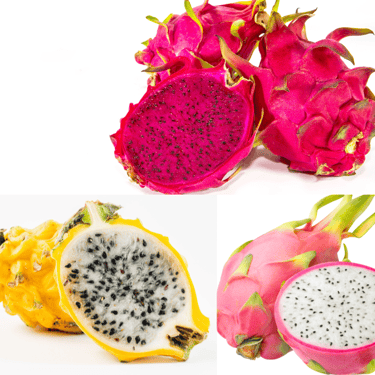
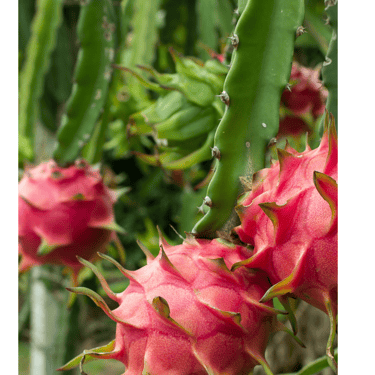
Soil and Climate:
Dragon fruits can be cultivated in arid tropical and subtropical climate. It can tolerate temperature as high as 45ºC and as low as to 5ºC for a short period of time. Can be grown in the region yearly rainfall ranging from 110 -250 cm. In area of heavy rain fall proper drainage has to be ensured to avoid water logging. In high rain fall area plants may be established on raised bunds. At higher temperature during summer, plants may show sunburn, characterized by yellowing and withering of leaf blades.
Dragon fruits can be grown in variety of soil from clay or loamy or sandy loam. Any soil with which is rich in organic matter is preferred.
Spacing and Planting
Recommended spacing for dragon fruit plants is 3mx3m. Same may be varied according to requirement. In area of heavy rain fall, space between the rows may be increased to have broader drainage channels. Leaving the proper space is very important as planting requires strong supports to sustain for a period of 15-20 years. At the same time plants keep spreading fast with spiny stems and not leaving optimum space may pose a problem for moving around the plants for fruit harvesting and for carrying out intercultural operations.
Being a succulent and climbing type of cactus, dragon fruit plants need strong and durable supports to climb up and properly establish. Usually concrete or stone cut poles ( in parts of Karnataka) of height 6 to 7fts are used. Supports are to be buried deep enough into ground , usually at the depth of one feet.
Propagation of Dragon fruit plants is mainly done through cutting and rarely by seeds. Propagation by cutting is easy and speedy way to have well established orchard. Branches of healthy, free from disease, fruit bearing mother plant are selected and cut to a length of 30 cm. Cuttings are planted directly in the main field or allowed to root in rooting medium in poly bags. Cutting are planted around the support, preferably 3 to 4 cuttings per support. Same to be kept tying to support using threads till plant reaches the top of the support. Ring like structures made up wood or concrete or rubber are places at the top of the supports from where branches are spread laterally.
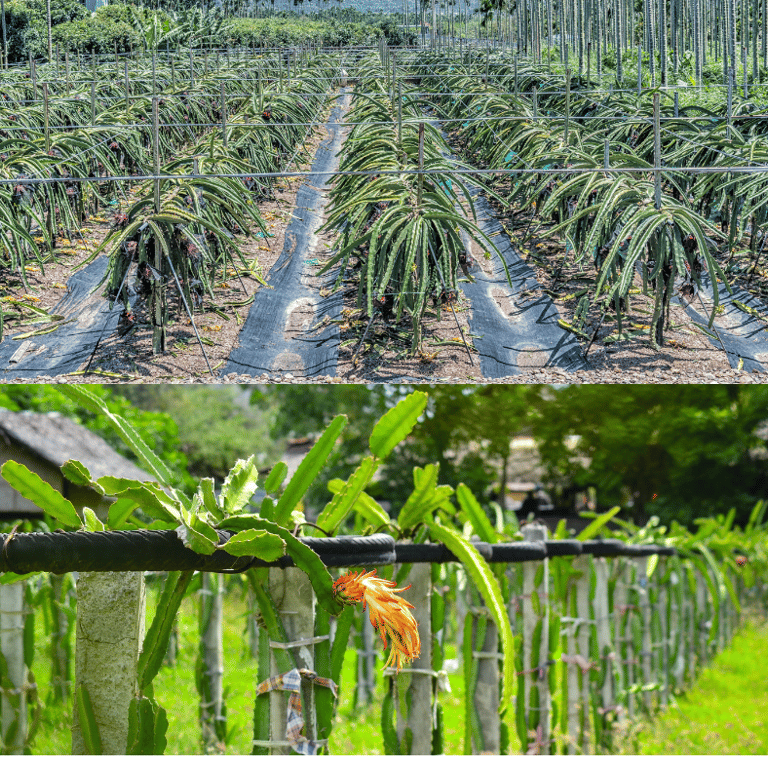
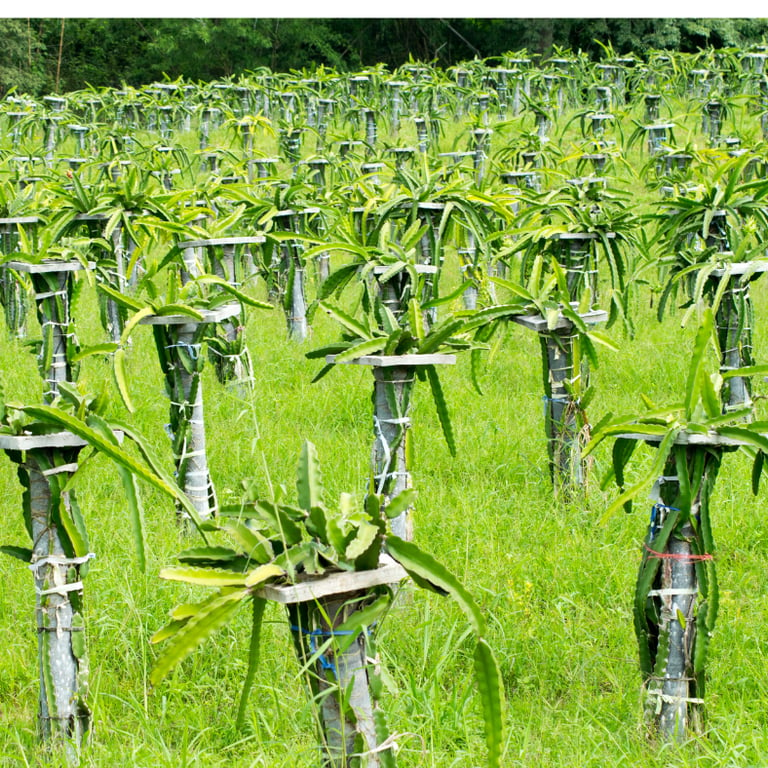
Pests and Diseases of Dragon fruits
There are many diseases and pest found attacking dragon fruit plants causing much harm and economic loss. Growth of weeds acts as alternate hosts to insects and pathogens. Continuous rain which causes water logging and keep the humidity level high, encourages both pest and disease incidences. Important diseases attacking dragon fruit are briefed below.
Stem rot: It is caused by fungus. Xanthomonus Sps. Some times damage is more severe in combination with some bacteria like Colletotrichum sps. . Main symptoms is formation of reddish brown lesions with pale center on stem and leaf blades. The lesion soften the affected parts and get detached from plants.
Stem and fruit canker: It is also a disease caused by fungus. In this case sunken spots are seen on stem, some times on fruits. Later these spots grow larger and coalesce to form larger dark brown spots.
Stem Rust: Symptoms starts with formation orange color spots on stem and later coalesce to rotting of affected portion. In advanced stage the disease skeleton entire plant by rotting and shedding of tissues.
Nematode infestations: This is also a major cause of concern, where plant roots are infested, leading withering and stunted growth. It drastically affect the flowering and fruiting in plants.
In all the cases affected plant parts are collected and destroyed and suitable copper based fungicides or nematicides are sprayed.
Important insects attacking the crop are oriental fruit flies, mealy bugs, thrips and ants.
Fruit flies: Flies lay eggs on flower or tender fruits and on hatching maggots start feeding on fruit pulp leading to rotting and premature falling. Some times damage extends to post harvest stages and fruit start rotting during storage. This can be controlled by using suitable insect traps.
Mealy bug and Thrips: These are the sucking insects attacking the dragon fruits. They suck the sap from tender shoots and floral parts. These insects secretes some sugary substances that attract ants. Affected portions wither and dry. These can be controlled by plant based insecticide at ease if infestation level is low and should go for pesticides spray if alarming.
Ants: Ants are noticed infesting plants and feeding on flower nectars and rotting fruits. Some times they found in association with any sap sucking insects which secrets honey dew like substances.
Harvesting of dragon fruits:
Dragon fruit plants start bearing fruit from 12 to 15 months after planting. Change in color of fruit skin from green to red or yellow (depending on species) is an indication of ripening. Same to be plucked from plant with in a week time of color change. Harvesting of fruits can be done once in a week. Fruits are available to harvest from April to October. 30 to 35 kgs of fruits/post can be harvested from three year old plantation.
Cultivation of dragon fruit is looking promising and lucrative venture. It needs initial investments no doubt, but its break even reaches with in a few years. Farmers need not wait for more than 18 months for harvesting yield and expect higher yield as years progress. Maintaining the orchards organic way may lead to sustained productions and better quality fruits.
Newsletter
Sign up for our newsletter and get notified about all new posted articles.
ADDRESS
House No. 2-113(P), Visnumurthynagar, Kelarkalabettu, Thenkanidiyuru, Udupi
cONTACT
7975809540
satishmqc362@gmail.com
